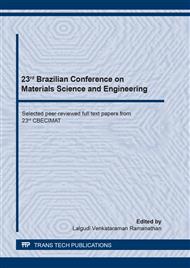p.215
p.221
p.227
p.233
p.239
p.244
p.250
p.256
p.262
Microstructural Characterization of Slag Residue Incorporated into Clay for Production of Red Ceramics
Abstract:
This study aims to characterize slag and from a steel mill and clays from in the state of Pará, aiming at its incorporation into clays for tiles production. The waste passed through the processing step X-ray diffraction (XRD) and X-ray fluorescence (XRF) were performed. Besides that, strong and weak clays from state of Pará were also analyzed by thermogravimetric analysis (TGA), scanning electron microscopy (SEM) and XRD. The results showed that hematite, magnetite and wustite are the predominant phases. The chemical analysis by XRF showed that the residue presents low levels of silica (SiO2) and alumina (Al2O3) associated with elevated levels of iron oxide. Thus, the characterization of steel slag showed that this residue presents itself as a potential ceramic constituent and can contribute to the formation of liquid phase during which it would lead to improvement of technological properties such as water absorption and mechanical resistance.
Info:
Periodical:
Pages:
239-243
Citation:
Online since:
October 2020
Keywords:
Price:
Сopyright:
© 2020 Trans Tech Publications Ltd. All Rights Reserved
Share:
Citation:


